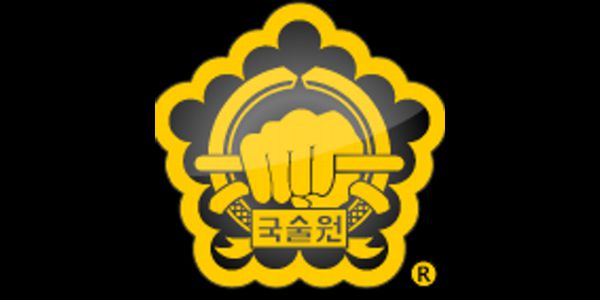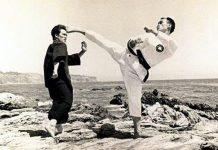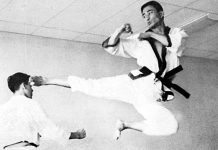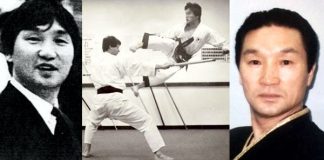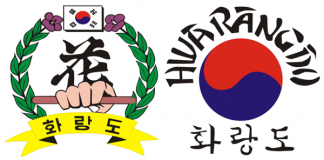Kuk Sool Won is beautiful and dynamic “hard-soft” style of martial arts emphasizing speed and fluidity. At the same time it is an elegant and powerful system which integrates the body, mind and spirit. Kuk Sool uses physical training and forms to develop internal power. Self defense techniques build confidence and keep the joints supple.
Kuk Sool Won, which can be translated as Korean National Martial Arts Association, is a systematic study of all of the traditional fighting arts which together comprise the martial arts history of the Korean nation. As such, Kuk Sool Won is an extremely well-organized system of martial arts which seeks to integrate and explore all aspects of the traditional Korean martial arts.
Although Kuk Sool Won as it is practiced today is relatively new, it’s roots stretch far and deep to the very beginnings of the history of the Korean people. As students of Kuk Sool, this early history and the ancient traditions upon which our art is founded should be as important to us as the physical techniques themselves, for it is only from our understanding and appreciation of these classical roots that we are able to grow as students and as martial artists
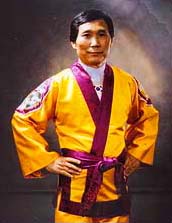 Grandmaster In Hyuk Suh spent more than 50 years in single-minded practice and research in order to learn, compile, master and organize the more than 3,608 techniques that comprise KUK SOOL. He founded the Kuk Sool Won (National [Korean] Martial Arts Association) in 1961 and brought it to the United States in 1974. The World Kuk Sool Association, headquartered in San Francisco, California for 17 years, relocated to Houston, Texas in 1991. This Association has since grown to include more than 1,000 member schools in Asia, Europe, Canada, the Middle East, and the Americas, and continues to grow in strength and numbers daily.
Grandmaster In Hyuk Suh spent more than 50 years in single-minded practice and research in order to learn, compile, master and organize the more than 3,608 techniques that comprise KUK SOOL. He founded the Kuk Sool Won (National [Korean] Martial Arts Association) in 1961 and brought it to the United States in 1974. The World Kuk Sool Association, headquartered in San Francisco, California for 17 years, relocated to Houston, Texas in 1991. This Association has since grown to include more than 1,000 member schools in Asia, Europe, Canada, the Middle East, and the Americas, and continues to grow in strength and numbers daily.
For self-defense, KUK SOOL is unsurpassed. It is a beautiful and dynamic “hard-soft” style emphasizing speed and fluidity. It covers the entire spectrum of the traditional Asian fighting arts and techniques of body conditioning, as well as mental development and traditional weapons training. These include (but are not limited to):
Hand Striking
- Closed and open hand striking methods including palm, fist, finger-striking techniques and specialized hand training techniques
- Pressure-point striking
- Striking using the arm and shoulder
- Blocking and parryingLeg Techniques
- Foundational kicks
- Spinning kicks
- Jumping kicks
- Combination kicks
- Double leg kicks
- Pressure-point kicking
- Specialty kickingThrowing and Grappling
- Body throws
- Projection throws
- Leg throws
- Pressure-point grappling
- Grappling defenses
- Wrestling techniques
- Ground fightingJoint-Locking Techniques
- Restraining methods
- Joint-locking techniques
- Combination joint-locking
- Control and redirection techniques
- Arresting and “come-along” techniquesFalling Techniques and Acrobatics
- Body conditioning and agility techniques
- Body protection techniques: offense and defenseAnimal-Style TechniquesBased on the movements and/or characteristics of certain “martial” animals such as the Tiger, Praying Mantis, Crane, Eagle, Snake, etc.Traditional Korean Weapons
- Sword (geum): short, middle and long; single or double; straight or inverted
- Staff (bong): short, middle and long; single or double
- Flail (jool bong)
- Spear (chang)
- Walking Cane (jee peng ee)
- Rope (poh bahk)
- Fan (bu chae)There are 24 different traditional Korean Royal Court weapons in the curriculum of Kuk Sool Won, plus Buddhist and family weapons.Martial Art Healing Methods (Beginning at Instructor Level)
- Acupressure
- Acupuncture
- Internal energy systems
- Herbal medicineMeditation and Breathing Techniques
- Various breath control techniques
- Meditation and breathing postures
- Concentration techniquesAs you can see, Kuk Sool Won covers an extensive variety of techniques and martial arts methods, but it is not merely concerned with the physical methods of attack and defense. Kuk Sool Won includes the study of healing techniques, the development of internal power, and physical conditioning. Training in Kuk Sool Won also helps to instill self-confidence and self-discipline, a calm self-assurance, and the psychological and spiritual values which are traditionally associated with the martial character. Mental and physical well-being is of primary importance in Kuk Sool Won.Philosophically, Kuk Sool stresses humility, self-discipline, self-control, loyalty and respect for others. Together, these aspects of Kuk Sool provide the means for attaining a long and healthful life.
YOU WON HWA The theory of YOU-WON-HWA is the foundation of Kuk Sool Won training.From the theory of YOU (flowing, as in water), we learn to “go with the flow.” When we are pushed, we pull; when we are pulled, we push. Also, water symbolizes many things, not the least of which are adaptability, softness and at the same time, great force. The theory of WON (circle) acknowledges that every person has his or her own circle of “private space.” Attacks which invade this space should be redirected with flowing and circular defensive motions. This circle should be thought of as least resistance; always rolling (active), and therefore, difficult to hold or grasp.
Finally, the theory of HWA (harmony) represents the unity of mind and body. In practice, this is accomplished through repetition. Harmony is achieved within oneself, through a state of “emptiness” that recognizes “+” (yang) and “-” (um) are part of one; each is there to allow the other to exist, and cannot exist if the other part is not there.
The ramification of the theory of YOU – WON – HWA is that as flowing water seeks a harmonious state with its environment, constantly adapting to external changes, we should also seek to maintain harmony within our inner circle so that all trespassers in this space are redirected in direct proportion to the force they introduce.

